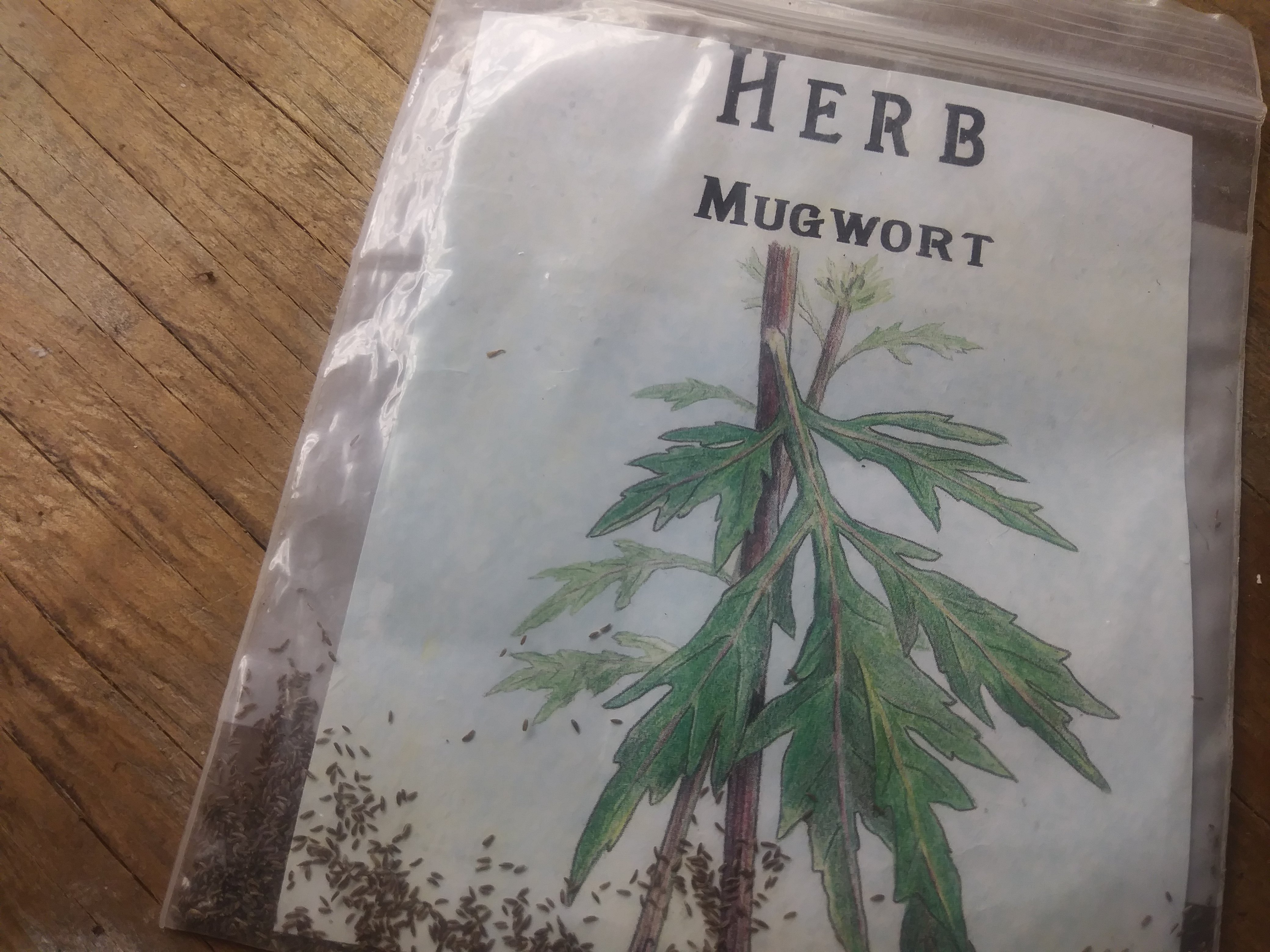Isn’t Mugwort a School For Wizards?
Nope. It’s an herb. Mugwort is a medicinal herb that treats a wide variety of maladies and complaints, and was used by American Indians in the west for spiritual protection. This easy to grow perennial grows all over the world, and is almost care free when grown in the garden. There’s a lot to say about mugwort, so let’s dive in.

What’s in a name?
Mugwort’s scientific name is Artemisia vulgaris. ‘Vulgaris’, meaning common. ‘Artemisia’ after the Artemis, goddess of the moon, of the herbalist, of the midwife and of the birthing woman. The underside of the leaves of mugwort are silvery, like the moon and the traditional symbol of the midwife and the herbalist is mugwort.
Mugwort, like so many other herbs, is known by many names. Sailor’s tobacco, felon herb, naughty man and old uncle Henry are a few of my favorite names for mugwort.
Warning!!!!!
Before we get too far into the use of mugwort for medicinal purposes, I want to make it clear that I am not trained in the use of herbal medicine. I use herbal medicine after careful research. I suggest that you DO NOT take my word for the safety or effectiveness of any herbal medicine! It is your responsibility to research the pros and cons of using herbal medicine.
DO NOT use mugwort if you are pregnant, think you may be pregnant or want to become pregnant!!! Do not use if you are nursing!!! Mugwort can induce miscarriage.
Mugwort contains thujone, which is responsible for many of it’s medicinal properties. But because, in high doses, thujone can be toxic, mugwort should be used with caution.
Medicinal Uses
Mugwort treats a whole host of abdominal complaints. Both diarrhea and constipation, as well as abdominal cramps, weak digestion, nausea and vomiting can be treated with mugwort tea. Mugwort oil can be used to stimulate the production on gastric juices and bile secretions.
Mugwort tea can be used to promote circulation. It’s also known to promote a regular menstrual cycle, and lessen the fatigue, cramps and headaches that accompany it.
A poltice made from the leaves of the mugwort plant can be used to treat insect bites, and the tea can be used to stop the itch from rashes. Burn scars can be terribly itchy, the poltice or tea can be used to stop the itch. Mugwort poltice can also relieve the pains and speed the healing of chilblains.
Like many herbs, mugwort is antifungal and antibacterial. The leaves can be used to prevent infection in scrapes and cuts. The whole leaves, it’s said, were used by Roman soldiers in their sandles to prevent and treat sore feet.
The oil can be used to promote kidney and liver health. It also speeds the healing of bruises and is an effective treatment for intestinal parasites in humans and pets. Mugwort oil helps to rid the body of toxins that cause gout, rheumatism and other conditions. The oil helps to rid the body of uric acid, excess water, salt and fat. Weight loss may be promoted with the use of mugwort oil.
Other medicinal uses for mugwort include treatment of nosebleeds, insomnia, chest congestion, allergies and depression.
Traditional Use of Mugwort in America
American Indians used mugwort. The Chumash Indians called it Molush. The Paiute name for mugwort is translated as Dream Plant. Although it was used medicinally, it was also an important plant used in spiritual ceremonies. Mugwort tea was regularly used to improve dreams, making it easier for the dreamer to interact with the dream, and making the dream easier to remember. The dried herb was smoked or burned as incense to counter insomnia. It was also sewn into pillows, and used to prevent nightmares, particularly for children, much like a dream catcher.
Something You Can Do At Home
Mugwort was often tucked into a pouch and attached to dream catchers. Dream catchers have become pretty popular, and they aren’t difficult to make. @calluna has written an excellent, two part dream catcher howto. Part one covers material collection and weaving the web. Part two gives instruction on cleaning and attaching the feathers, and other decoration for your dream catcher.

Using Mugwort, Preparation and Dosage
The traditional and most common way to use mugwort medicinally is in the form of tea. Most herbalists suggest drinking 2 cups of tea a day for the treatment of most complaints.
To make mugwort tea: pour boiling water over 1 to 1.5 heaped tsp of dried mugwort. Cover and allow to infuse for 8-10 minutes. If the tea is too bitter, the addition of lemon balm can cut the bitterness.
Wanna Grow Some?
Well, it’s super easy. Mugwort isn’t super picky about it’s soil, it only requires good drainage, and it loves the sun. Be careful about planting it in beds with other plants because it’s roots put off chemicals that inhibit the growth of other vegetation. So, getcha some seed, and sow it in a sunny, dryish place, all by itself, and let this useful, hardy perennial establish itself in your garden. :)
*All photos are mine. :)



